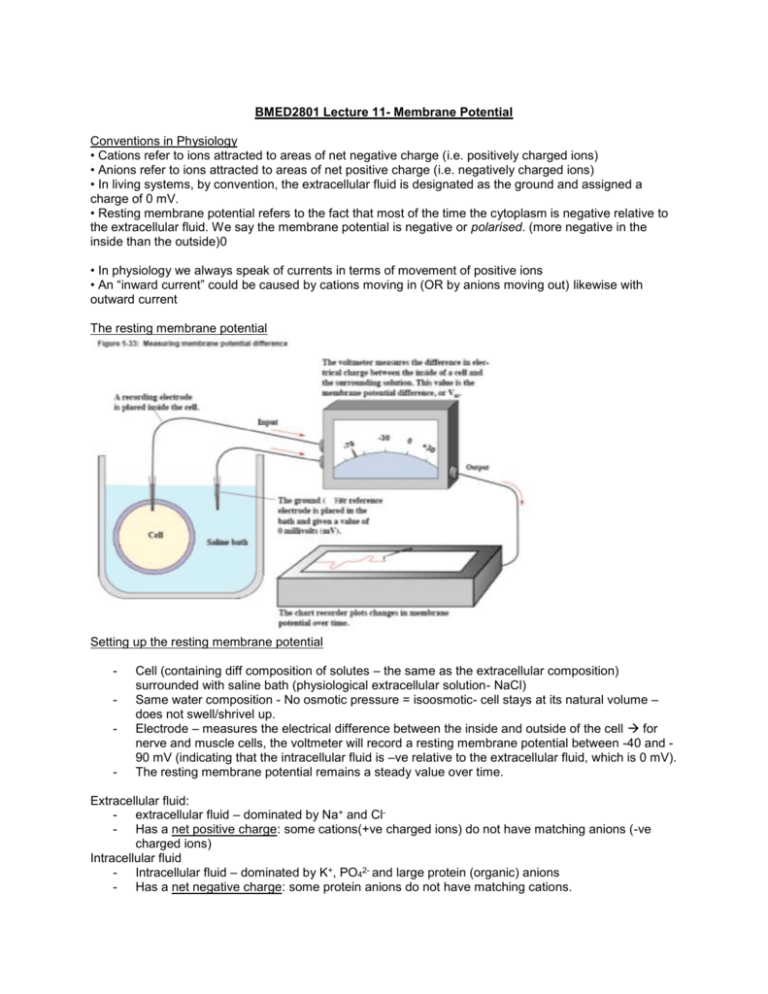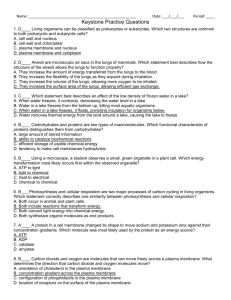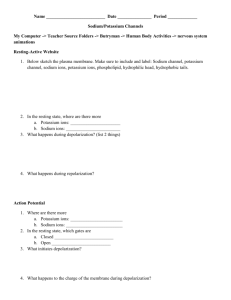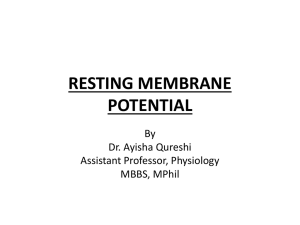BMED2801 Lecture 11- Membrane Potential Conventions in
advertisement

BMED2801 Lecture 11- Membrane Potential Conventions in Physiology • Cations refer to ions attracted to areas of net negative charge (i.e. positively charged ions) • Anions refer to ions attracted to areas of net positive charge (i.e. negatively charged ions) • In living systems, by convention, the extracellular fluid is designated as the ground and assigned a charge of 0 mV. • Resting membrane potential refers to the fact that most of the time the cytoplasm is negative relative to the extracellular fluid. We say the membrane potential is negative or polarised. (more negative in the inside than the outside)0 • In physiology we always speak of currents in terms of movement of positive ions • An “inward current” could be caused by cations moving in (OR by anions moving out) likewise with outward current The resting membrane potential Setting up the resting membrane potential - - Cell (containing diff composition of solutes – the same as the extracellular composition) surrounded with saline bath (physiological extracellular solution- NaCl) Same water composition - No osmotic pressure = isoosmotic- cell stays at its natural volume – does not swell/shrivel up. Electrode – measures the electrical difference between the inside and outside of the cell for nerve and muscle cells, the voltmeter will record a resting membrane potential between -40 and 90 mV (indicating that the intracellular fluid is –ve relative to the extracellular fluid, which is 0 mV). The resting membrane potential remains a steady value over time. Extracellular fluid: - extracellular fluid – dominated by Na+ and Cl- Has a net positive charge: some cations(+ve charged ions) do not have matching anions (-ve charged ions) Intracellular fluid - Intracellular fluid – dominated by K+, PO42- and large protein (organic) anions - Has a net negative charge: some protein anions do not have matching cations. - An electrical gradient between the extracellular fluid and the intracellular fluid is known as the resting membrane potential difference. Resting- comes from the fact that this electrical gradient is seen in all living cells and has reached a steady state is not changing. Potential- comes from the fact the electrical gradient created by active transport of ions is a form of stored energy. Difference- the membrane potential represents a difference in the amount in of electrical charge inside and outside of the cell. The electrochemical gradient For e.g. -An active transport carrier protein is inserted into the membrane. -This carrier uses energy to move positive ions out of the cell against the concentration gradient- negative ions attempt to follow the positive ions because of the attraction. -But because the membrane is impermeable to negative ions they remain trapped in the cell. -As soon as the first positive ion leaves the cell the electrical equilibrium between the extracellular fluid is disrupted- the cells interior has a net charge of -1 while the cell exterior net charge of +1. -the input of energy to transport ions across the membrane has created an electrical gradient (a difference between the net charge in two regions-inside cell - and outside +) - this further results in a concentration gradient (there are more positive ions outside the cell than inside) -the combination of electrical and concentration gradients = electrochemical gradient. Balance of electrical charge and transmembrane currents Balance of electrical charge on the membrane depends upon: • Number of positive charges (cations) inside minus negative charges (anions) inside • Number of cations outside - anions outside • For membrane potential to change cations or anions must SELECTIVELY cross the membrane • Only a tiny fraction of unbalanced cations is required to produce biological potentials (<0.1V) • A movement of charge across the membrane is called an ionic current (amount of charge/time) • Depolarisation or imbalance of charge – is a result of the opening of ion channels – moving of ions across the membrane, and these ion not taking with them their counter ions. • Ion channels permit and initiate transmembrane ionic currents Imbalance of charge For an imbalance of charge to occur = electrical difference – Some ions need to move across the membrane without taking with them their partner ions. e.g. if a positively charged potassium ion diffuses out of the cell through ion channels- leaving behind large organic anion trapped inside the cell – generating net negative charge inside – because anion is not balanced by a cation. How many anions/cations need to be unbalanced to produce physiological electrical potentials? = really small proportion – only tiny fractions of cations/anions need to move in or out of a cell leaving behind their counter anion/cation – to produce physiological potentials that equates to -65mv During normal physiological signaling – we do not require a v. substantial movement of cations across the membrane to produce – physiological potentials - Only a tiny fraction of potassium moves out the cell to produce physiological potentials - The chemical driving force (the concentration gradient that produces the chemical driving force) does not change significantly– is mostly stable. Ion selective channels - Are the crucial element in determining the membrane potential of the cell - there are many different ion channels that are either partially or completely selective e.g. voltage gated sodium channels selective permeability Non gated – aka leakage channels- open all the time – constant trickle of potassium to diffuse out of the cell or sodium to diffuse into the cell – which is essential to establishing the resting membrane potential of the cell. Descriptions of ion channels • Leakage channel -Pore open continuously • Voltage-gated - pore opens when Vm rises (only open during signaling) • Ligand-gated-pore opens when ligand binds to extracellular part of receptor • ‘calcium channel’ -pore is permeable to Ca2+ • ‘Cation channel’ - Pore is permeable to cations including Na+, K+ and often also Ca2+ Demonstration - Concentration gradient and electrical forces work against and sometimes with each other in order to establish membrane potential. What would happen? - positively charged potassium ions are concentrated in the intracellular fluid – balanced by organic anions - 8 potassium ions + 8 organic ions = 0 potential difference - There is a chemical driving force – conc. of potassium ions higher inside the cell than outside the cell – there is a chemical driving force pointing out of the cell. - Effect of chemical driving cell movement of potassium ion out via ion leakage channels = imbalance of charge results in an electrical force pointing into the cell - - another potassium ion moves out – leaves another organic ion behind increase in imbalance of charge (a greater electrical force pointing into the cell, and a decrease in the chemical driving force pointing out of the cell) An equilibrium potential will be reached = no net force this is the Nernst potential! The resting membrane potential is due mostly to potassium What processes go on in living cells to create an electrical gradient? - Real cells are not completely impermeable to all ions- they have open channels + protein transporter that allow ions to move across the membrane. - E.g. artificial cell with membrane impermeable to ions. -Cell contains K+ and large negatively charged proteins the cell is placed in a solution of Na+ and Cl -. -The cell and solution are electrically neutral- is in electrical equilibrium- however, it is not in chemical equilibrium. - There are concentration gradients for all 4 types of ions in the system and they would all diffuse down their respective concentration gradient if they could cross the cell membrane. -If a K+ leak channel is inserted into the membrane, making permeable to K+ K+ would leak out the cell moving down the concentration gradient. Leaving negatively charge proteins unstable- the proteins gradually build up a negative charge inside the cell as more and more K+ diffuses out of the cell. The loss of positive ions from the cell creates an electrical gradient. -The organic anions will try to pull K+ back into the cell. -At some point in the process the electrical force attracting K+ into the cell becomes equal in magnitude to the chemical concentration gradient driving the K+ out of the cell= equilibrium potential. i.e. the rate at which K+ move out of the cell down the concentration gradient is exactly equal to the rate at which K+ move into cell down the electrical gradient. -Now we will use the same artificial cell but this time make the membrane permeable only to Na+. -Na+ is more concentrated outside the cell so some Na+ will move down their concentration gradients into the cell and accumulate there. -Meanwhile Cl – left behind in the extracellular fluid gives that compartment a net – charge. -This imbalance creates an electrical gradient that tends to drive Na+ back out of the cell. - The chemical gradient and electrical gradient will eventually reach an equilibrium potential. See diagram below. The Nernst equation: - Mathematical expression of the effect of an ion on the membrane potential of the cell. - the Nernst potential = equilibrium potential (chemical driving force = electrical driving force) - If a cell is permeable to several ions, we cannot Nernst equation to calculate membrane potential. Instead we must use a related equation called the Goldman equation that considers concentration gradient of the permeable ions and the relative permeability of the cell to each ion. Note: Temperature is important: Above absolute zero – atoms move. The higher the temp, the greater the thermal energy, the greater the diffusion force – therefore the greater the chemical driving force, moving ions down their concentration gradient Changes in temperature become an issue for cold blooded animals- partly because of the Nernst Potential Natural logarithm The natural logarithm of a concentration difference between concentration outside the cell of potassium and the intracellular concentration of potassium- in a healthy cell this does not change greatly. If we were to know for E.g in a typical cell, concentration inside cell 20X greater inside the cell than outside, we can estimate the natural logarithm of a typical cell- we find a negative potential . Concentration gradient, temp and valence of the ion – main factors contributing to natural logarithm. Each ion has a different concentration gradient – potassium is in the outside of the cell - so the fraction is inverted, as a consequence sodium has a positive Nernst potential, and negatively charged chloride has a negative Nernst potential. Remember: if a positive ion is concentrated outside the cell it will diffuse into the cell and raise the membrane potential e.g. sodium if negatively charged (chloride) ion is concentrated outside the cell, diffusing in will lower the membrane potential the Nernst equation is just a mathematical method of accurately determining the effect of an ion upon the membrane potential It is impt. because it allows us to predict the effect of ion movement on the membrane potential. Typical Nernst/equilibrium potentials (in healthy neurons) • Nernst Potential for K+ ~ -75mV • Nernst Potential for Na+ ~ +55mV • Nernst Potential for Cl- ~ -60mV • REMEMBER: Nernst Potential for an ion depends upon the concentration gradient in the cell in question Health normal cell - The Situation – sodium+ chloride conc outside cell, potassium + organic ion conc inside cell - Potassium is constantly diffusing out of the cell through non gated potassium leakage channelsdriving the membrane potential to a negative = negative membrane potential chemical driving force is outwards, electrical driving force opposing it gets bigger and bigger as more and more potassium ions diffuse out - Diffusing of potassium is more impt – because in resting membranes – there are more potassium leakage channels than sodium leakage channels + 20x more channels that are permeable to potassium than sodium in a resting cell. - Potassium – drags membrane potential down towards its Nernst potential, once reached it would stop diffusing, but never reaches the Nernst potential because of the opposition of sodium. As the potassium diffuses out, it makes inside of cell more negative – results in a chemical driving force for sodium to diffuse into the cell (movement of sodium from high conc. to inside where there is a lower conc.) + when the membrane is polarized (resting state) - there is an electrical force attracting sodium into the cell = chemical + electrical driving force for sodium to diffuse into the cell but there are vey few sodium leakage channels + low permeability. - As potassium nears as Nernst equilibrium get closer – force on gets weaker, force on sodium gets stronger – electrical + chemical force pulling sodium into the cell works in unison. - Stable situation – where the driving force on sodium sufficient to get it into the cell to cancel the movement of potassium out of the cell. Inward Na+ diffusion is limited by the lesser permeability of the membrane to Na+ than K+ (relative permeability) As outward K+ diffusion polarizes the membrane, the combined force - Inward driving force on Na+ (chemical + electrical) increases ‘Resting’ membrane potential • Most of the time the Vm (potential) of the neuron is steady • The Resting Vm is NOT an equilibrium because there is a net movement of Na+ and K+ across the membrane • The Vm doesn’t change because the rate of K+ out of the cell is balanced by the rate of Na+ diffusion in to the cell • Energy is needed to maintain ‘resting Vm’ Graded potentials perturb resting Vm • Brief increases in the permeability of the membrane to Na+ can be produced by the opening of ligandgated ion channels at a synapse • The ratio of permeability to Na+ is temporarily increased, relative to K+ • More Na+ diffuses in than K+ out (a net inward current) • The membrane potential rises proportionally. This synaptic potential is an example of a graded potential - In this system – we have a constant movement of sodium in and potassium out The electrical driving force helps buffer the membrane potential (Vm) against sudden changes. - Excitatory inputs (inward current of sodium at a synapse) results in a transient increase in membrane potential. - increase in membrane potential – is buffered If little bit of sodium diffuses in at synapse Membrane potential rise - changes the electrical driving force on sodium and potassium electrical driving force opposing potassium chemical driving force decrease, net force on potassium gets bigger, more potassium ions diffuse out faster, - NET EFFECT= net outward potassium current drags membrane potential back down to resting potential. If Membrane potential decreases (More negative) – electrical driving force inward gets strongerpotassium starts diffusion out slower, sodium diffuses in faster. – Membrane potential rises back to its resting potential. To sum up: - The chemical driving force on an ion (due to its concentration gradient) doesn’t change significantly during physiological signaling, but the electrical driving force does, so… If Vm rises slightly (depolarization) the inward electrical driving force on K+ and Na+ will weaken, so the inward diffusion of Na+ will slow and the outward diffusion of K+ will accelerate producing a net outward current. - This will help bring Vm back down to its steady resting level. - Similarly if the Vm were to fall slightly (below resting level) the inward electrical driving force on K + decrease and Na+ will diffuses into the cell faster. - The Nernst potential physiological range of ion Ions is important – if not in this range diffusion will stop – there will be no more force to drive the whole system Relative permeability to ions • When the membrane is permeable only to K+, the membrane potential (Vm) will be equal to the Nernst Potential for K+ (EK) • When the membrane is permeable only to Na+, the membrane potential (Vm) will be equal to the Nernst Potential for Na+ • When the membrane is permeable to both K+ and Na+, then EK < Vm < ENa The resting membrane is about 20 times more permeable to K+ than to Na+. This is why the resting membrane potential is close to EK








